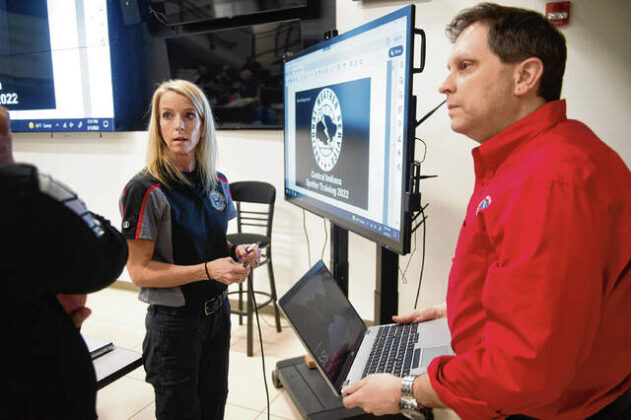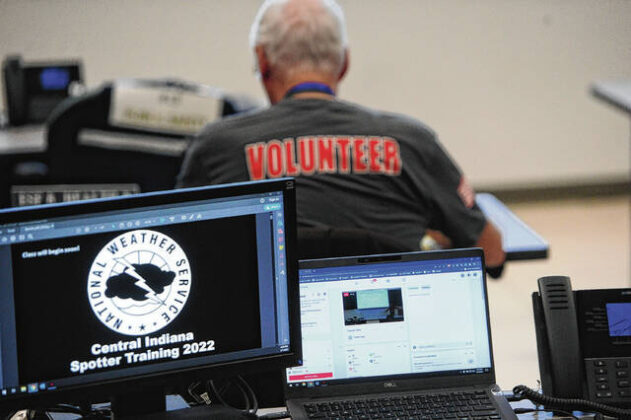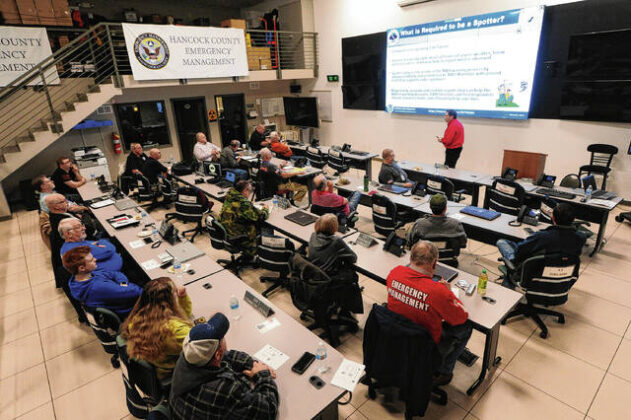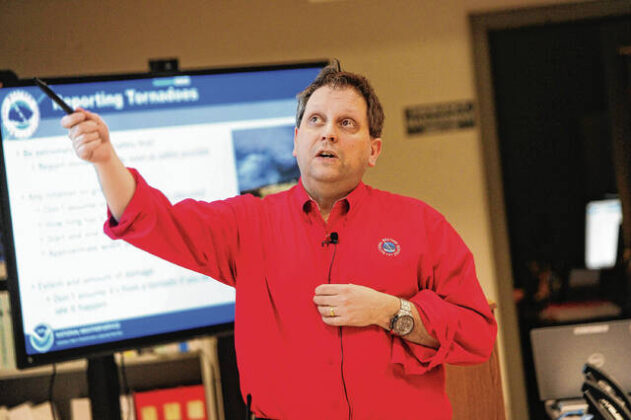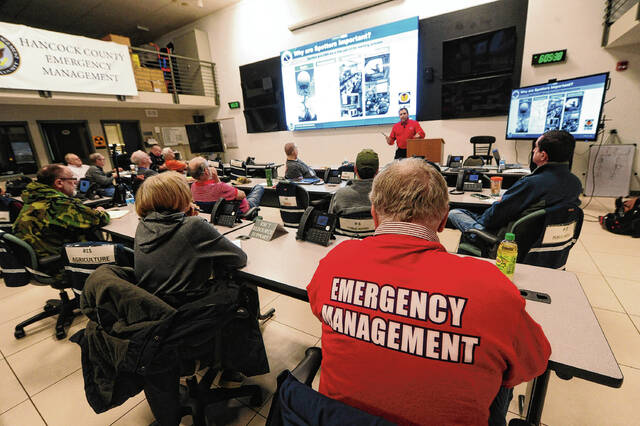
Tom Russo | Daily Reporter
Volunteers in attendance learned the many different examples and signs of what to look for when encountering hazardous weather situations during a recent weather-spotting class put on by Jason Puma with the National Weather Service.
Tom Russo | Daily Reporter
HANCOCK COUNTY — The good news is that most tornadoes that touch down do not reach the deadly Enhanced Fujita (EF) Scale designation of EF4 or EF5. Only about 2 percent reach the power of an EF4 or EF5 tornado, which can destroy an area and take lives within seconds. In fact, the last time one of those massive, powerful EF5 tornadoes hit Indiana was 48 years ago in 1974, National Weather Service meteorologist Jason Puma said.
The bad news, Puma noted, is the lessor tornadoes, ones identified as a EF0 or a EF1, which tend to be around 80% of the tornadoes that hit the state, can still have wind speeds as high as 112 mph and can do plenty of damage.
That information was just a sampling of the storm data Puma shared during Tuesday’s Weather Spotter training class hosted by the Hancock County Emergency Management Agency.
The session was designed for Emergency Management Agency volunteers and local residents who wanted to brush up on their weather-spotting skills, which allows them to share storm information with local and state officials now that spring is just around the bend.
“The weather never goes away,” said Misty Moore, director of the county’s Emergency Management Agency. “As we approach severe weather season, we always try to bring people together to learn more about weather spotting so they can help us help others.”
Weather spotters are referred to as “skywarn” spotters, public volunteers who want to learn more about the signs of approaching weather danger and share that information with officials who in turn share the information with the community.
“Spotters are trained to know what to look for, how to identify what they see and how to relay that information to emergency management or the National Weather Service,” Puma said.
Spotters are crucial, Puma noted, because they are there collecting credible information that needs to be shared as it is happening or beforehand. The group learned the difference between shelf and wall clouds, cold air funnels and tornado rotations, how to look for the width of a tornado and describe the wind damage they see, among other important weather indicators.
“We just need weather spotters to report the facts,” Puma said. “Things they are certain of — like a tree being down and where it might have snapped.”
Puma noted thunderstorm winds can be just as damaging as tornado winds. They can have speeds as much as a lower-end tornado in the 70 mph range.
“People should take these warnings just as seriously as a tornado warning,” Puma said.
Anyone can be a weather spotter Moore said, but getting the proper training, knowing what to really look for is important as official weather spotters can gather information that can actually save lives.
“There are higher levels of training too if people want to become a weather spotter for us,” Moore said.
While most of the people, nearly 30, attending the class were Emergency Management Agency volunteers, Sheriff Brad Burkhart watched the class along with several others who were part of a communications group led by Jeff Ferrell of the Hancock Amateur Radio Club, which specializes in operating ham radios.
“Those folks get even more plugged in as ham operators as well as certified weather spotters,” Moore said.
Puma said that weather spotters are important because despite radar, meteorologists and experience with an environment, having eyes on the ground as storms approach and go through an area is valuable information.
“They can really help us try to keep people safe,” Puma said.
One of the other things spotters learned about was proper reporting procedures, such as who they are, what they have witnessed, when the event occurred and where the even happened by using road signs for location markers if possible.
“When it comes to reporting information, we do want people to think about their safety first,” Puma said. He then reminded spotters to never try to track a tornado at night when it’s just too dark and dangerous.
Greg Duda, public information officer for the Emergency Management Agency, said they have not been able to host the class for the National Weather Service the past couple of years because of COVID, so he was thrilled to see a packed house while others opted to watch the two-hour presentation online.
“It’s always good to give people a little bit more knowledge about storms so they know what to look for when we have severe weather,” Duda said.
He recalled the tornado that hit the Pendleton area in May of 2019, saying while it was a clear day for most of Hancock County, they received calls from Fortville spotters telling them bad weather was heading towards Pendleton.
Puma reminded everyone to make sure they use weather apps with alerts and warnings and to have a weather radio — something he recommended for everyone as well as having multiple ways for people to get their weather information.
In addition to hosting the class and streaming it live, local officials re-posted the presentation on social media. Those interested in learning about being a weather spotter can re-watch the class on the Emergency Management Agency Facebook page or reach out to officials there to learn more.

